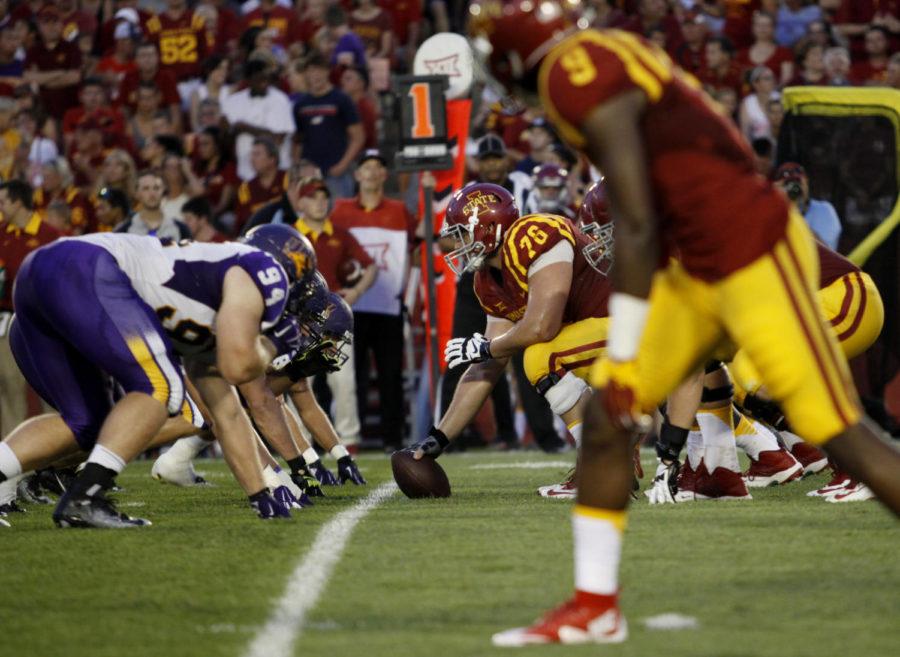Cyclones must hold the line against Hawkeyes
Iowa State’s offensive line gets ready to face off against Northern Iowa during a play Saturday September 6, 2015 in Jack Trice Stadium in Ames, Iowa. The Cyclones triumphed over the Panthers 31 to 7, scoring three of their four touchdowns in the second half.
September 9, 2015
Daniel Burton stood on the sidelines and watched as the Cyclones christened a revamped Jack Trice Stadium with a satisfying bit of retribution — a 31-7 manhandling of Northern Iowa.
Iowa State didn’t need Burton, its starting right guard, to hold the line against UNI’s athletic front seven. But Saturday’s Cy-Hawk matchup against Iowa’s defensive front will likely be a different story.
“This is probably the hardest-nosed, toughest defensive line we’ll play all year,” said senior right tackle Brock Dagel.
The challenge Iowa’s defense presents will require a more stalwart effort than what Iowa State’s offensive line put forth against UNI last weekend, when it showed itself to be one of the few shaky spots in an otherwise dominant ISU victory.
“I thought that [the offensive line’s] performance was just average,” said ISU offensive coordinator Mark Mangino. “I think we’re capable of better. I didn’t like the idea that we didn’t finish some blocks that we should have. … We had a couple of breakdowns in protection with the backs and the O-line that we have to get fixed.”
A disconnect exists between the offensive line’s opening performance and what Rhoads said of the position group at the end of fall camp — that it was not only the most improved area on the team throughout the preseason, but that its individual components were grading out higher than they ever had.
So the present concern as the battle for in-state bragging rights approaches isn’t depth of talent. It’s simply depth.
Heading into the season, eight players were expected to make up the line’s primary rotation. But backup center Patrick Scoggins went down for the season after rupturing a tendon in his leg four practices into camp.
Then, in the days leading up to the season-opener, Burton tweaked a knee and was sidelined.
All of the sudden, before even one game had been played, the ranks of the regular rotation had shrunk by 25 percent. It was a difficult loss to absorb, but one that was overcome against UNI, albeit it with some hiccups.
Despite Mangino’s reluctance to commit to the idea that Burton would be in the lineup against Iowa, Rhoads provided concrete optimism Tuesday that his thin but talented offensive line is likely to receive an important reinforcement.
“[Burton] practiced today, so I think we’re good to go,” Rhoads said. “It’ll be fun to have three guards and three tackles for sure, and be able to continue a rotation [with the guards] like we did with the tackles [last] Saturday.”
The experience Burton brings will be of considerable value to an ISU offensive line that surrendered seven tackles for loss, including four sacks, to UNI’s defense, adding up to a net loss of 22 yards from scrimmage.
The “up and down” struggles, as Dagel characterized them, spanned both the ISU passing and rushing attacks, and didn’t just manifest as negative-yardage plays.
Iowa State averaged 124.1 yards per game on the ground last season, good enough for the 108th ranked rushing attack in the country, according to ESPN.com. Per the same list, the Cyclones’ 3.7 yards-per-carry average slotted them at 98th in the nation.
After compiling 50 yards rushing on their first possession of the game against UNI, the Cyclones finished the day with only 77 ground yards on 32 attempts, producing an average of 2.4 yards per carry.
Those are significant decreases from what were already concerning numbers in 2014. Starting with Iowa, the defensive competition is only going to improve as the season wears on.
Part of those struggles may revolve around the Cyclones’ inexperience at running back, but one game isn’t likely to produce great strides of improvement at the position.
It will be up to the offensive line to pick up the slack by creating wider creases through which to run the ball against a Hawkeye defense that allowed Illinois State only 35 total rushing yards on 28 attempts.
“That’s tough sledding, you’re going to have a tough time gaining the kind of yards you want to on the ground with that,” Rhoads said of the space his offensive line created for ISU runners against UNI.
“I’d like to open up bigger holes and sustain blocks. And going against Drew Ott and the rest of [Iowa’s] formidable defensive line … we’re going to need to protect our quarterback.”
A smart, hard-nosed defense that doesn’t beat itself, as Mangino characterized Iowa, also has a talented secondary that adds pressure to the pocket by limiting a quarterback’s options and contributed heavily to the Hawkeyes’ five sacks and 10 tackles for loss against Illinois State.
The Cyclones must run the ball more effectively to create breathing room for Richardson and his talented wide receivers to flourish. But Dagel isn’t concerned.
Recent history, he says, is on the Cyclones’ side.
“We need to protect Sam better and we can protect Sam better,” Dagel said. “Traditionally, at least since I’ve been here, the biggest jump for the O-line has been from the first to second game. We traditionally have played outstanding against Iowa.”
The performance jump from the first game to the second should be even more pronounced this year with the addition of Burton’s presence. If the Cyclones hope to make Saturday a fourth victory against Iowa in the last five years, it’s going to have to be.







